ABS YAMAHA XVS1100 2000 Owners Manual
[x] Cancel search | Manufacturer: YAMAHA, Model Year: 2000, Model line: XVS1100, Model: YAMAHA XVS1100 2000Pages: 96, PDF Size: 13.11 MB
Page 12 of 96
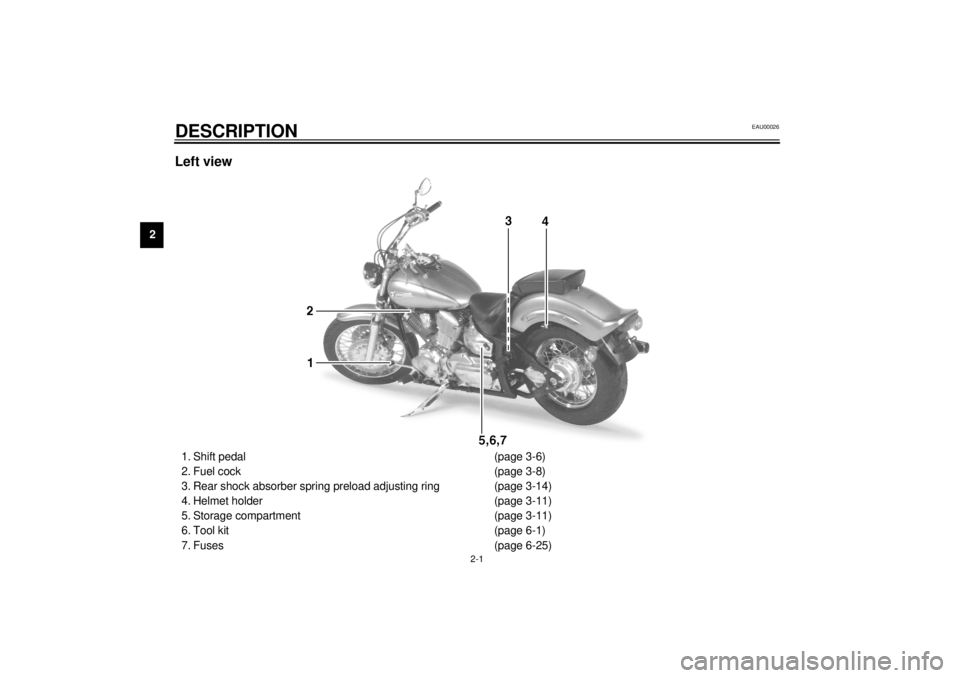
2-1
2
EAU00026
2-DESCRIPTIONLeft view1. Shift pedal (page 3-6)
2. Fuel cock (page 3-8)
3. Rear shock absorber spring preload adjusting ring (page 3-14)
4. Helmet holder (page 3-11)
5. Storage compartment (page 3-11)
6. Tool kit (page 6-1)
7. Fuses (page 6-25)
E_5el_Description.fm Page 1 Monday, May 1, 2000 9:37 AM
Page 15 of 96
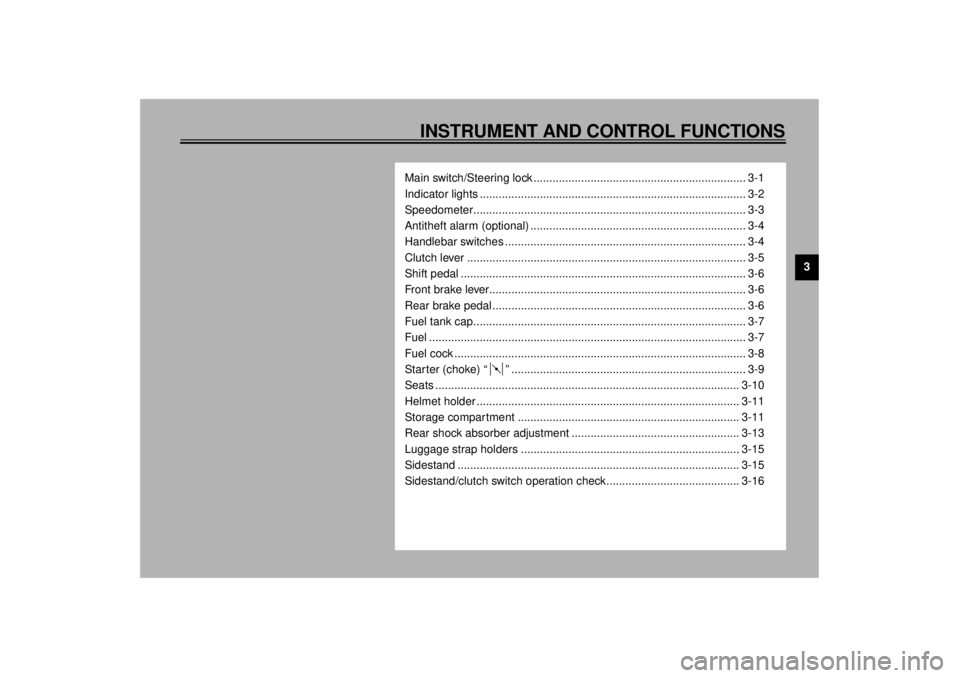
3
INSTRUMENT AND CONTROL FUNCTIONS
Main switch/Steering lock ................................................................... 3-1
Indicator lights .................................................................................... 3-2
Speedometer...................................................................................... 3-3
Antitheft alarm (optional) .................................................................... 3-4
Handlebar switches ............................................................................ 3-4
Clutch lever ........................................................................................ 3-5
Shift pedal .......................................................................................... 3-6
Front brake lever................................................................................. 3-6
Rear brake pedal ................................................................................ 3-6
Fuel tank cap...................................................................................... 3-7
Fuel .................................................................................................... 3-7
Fuel cock ............................................................................................ 3-8
Starter (choke) “ ” .......................................................................... 3-9
Seats ................................................................................................ 3-10
Helmet holder ................................................................................... 3-11
Storage compartment ...................................................................... 3-11
Rear shock absorber adjustment ..................................................... 3-13
Luggage strap holders ..................................................................... 3-15
Sidestand ......................................................................................... 3-15
Sidestand/clutch switch operation check.......................................... 3-16
E_5el_FunctionsTOC.fm Page 1 Monday, May 1, 2000 9:37 AM
Page 28 of 96
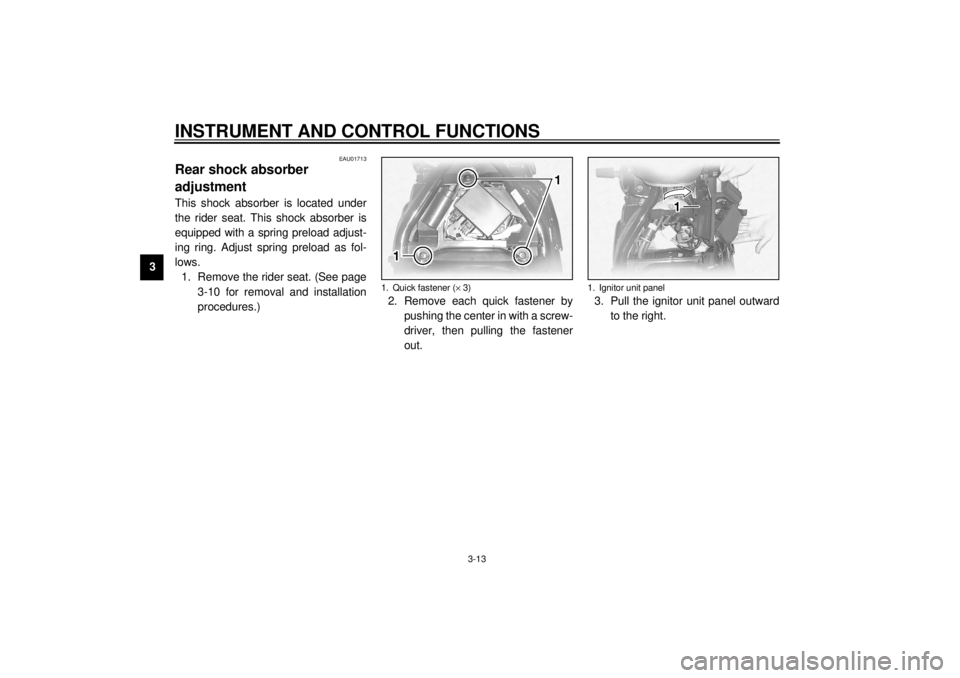
INSTRUMENT AND CONTROL FUNCTIONS
3-13
3
EAU01713
Rear shock absorber
adjustmentThis shock absorber is located under
the rider seat. This shock absorber is
equipped with a spring preload adjust-
ing ring. Adjust spring preload as fol-
lows.
1. Remove the rider seat. (See page
3-10 for removal and installation
procedures.)2. Remove each quick fastener by
pushing the center in with a screw-
driver, then pulling the fastener
out.3. Pull the ignitor unit panel outward
to the right.
1. Quick fastener (´ 3)
1. Ignitor unit panel
E_5el_Functions.fm Page 13 Monday, May 1, 2000 9:38 AM
Page 29 of 96
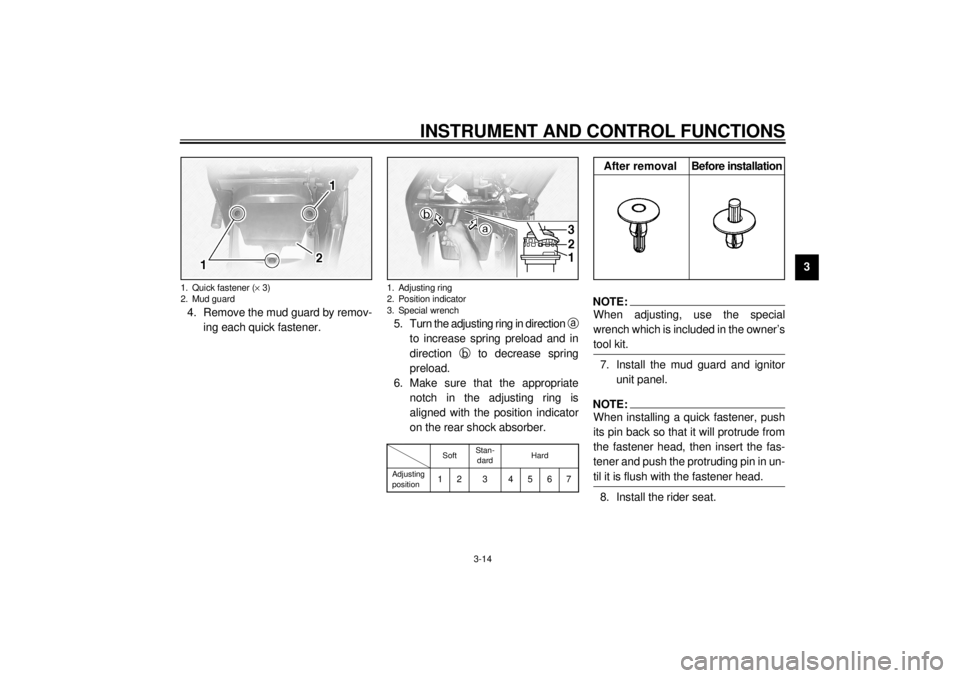
INSTRUMENT AND CONTROL FUNCTIONS
3-14
3
4. Remove the mud guard by remov-
ing each quick fastener.5. Turn the adjusting ring in direction
a
to increase spring preload and in
direction
b to decrease spring
preload.
6. Make sure that the appropriate
notch in the adjusting ring is
aligned with the position indicator
on the rear shock absorber.
CI-15E
NOTE:@ When adjusting, use the special
wrench which is included in the owner’s
tool kit. @7. Install the mud guard and ignitor
unit panel.NOTE:@ When installing a quick fastener, push
its pin back so that it will protrude from
the fastener head, then insert the fas-
tener and push the protruding pin in un-
til it is flush with the fastener head. @8. Install the rider seat.
1. Quick fastener (´ 3)
2. Mud guard
1. Adjusting ring
2. Position indicator
3. Special wrench
SoftStan-
dardHard
Adjusting
position12 3 4567
After removal Before installation
E_5el_Functions.fm Page 14 Monday, May 1, 2000 9:38 AM
Page 30 of 96
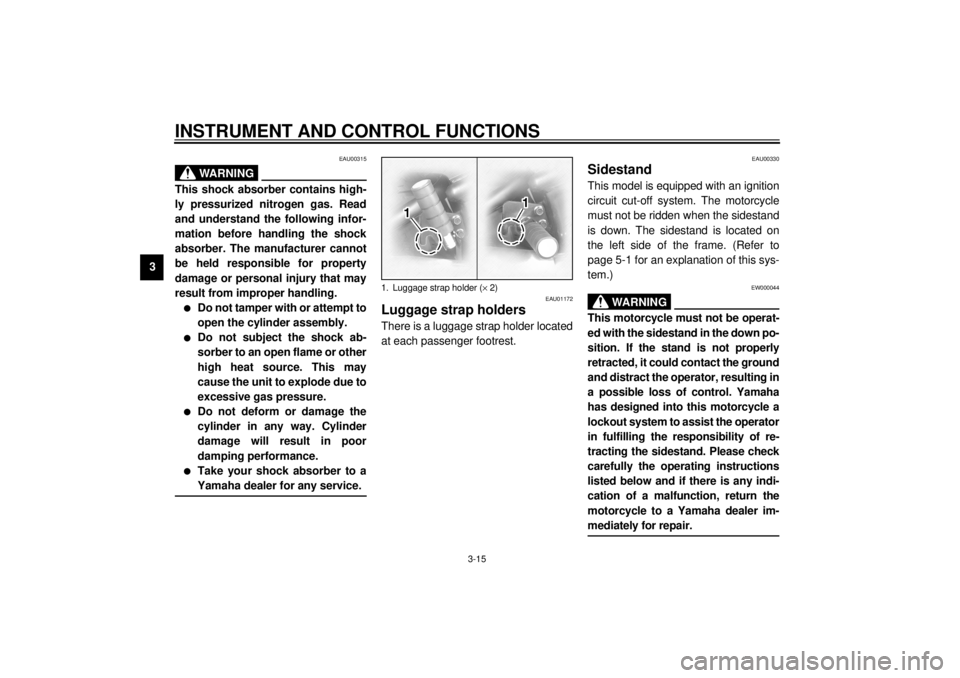
INSTRUMENT AND CONTROL FUNCTIONS
3-15
3
EAU00315
WARNING
@ This shock absorber contains high-
ly pressurized nitrogen gas. Read
and understand the following infor-
mation before handling the shock
absorber. The manufacturer cannot
be held responsible for property
damage or personal injury that may
result from improper handling.l
Do not tamper with or attempt to
open the cylinder assembly.
l
Do not subject the shock ab-
sorber to an open flame or other
high heat source. This may
cause the unit to explode due to
excessive gas pressure.
l
Do not deform or damage the
cylinder in any way. Cylinder
damage will result in poor
damping performance.
l
Take your shock absorber to a
Yamaha dealer for any service.
@
EAU01172
Luggage strap holdersThere is a luggage strap holder located
at each passenger footrest.
EAU00330
SidestandThis model is equipped with an ignition
circuit cut-off system. The motorcycle
must not be ridden when the sidestand
is down. The sidestand is located on
the left side of the frame. (Refer to
page 5-1 for an explanation of this sys-
tem.)
EW000044
WARNING
@ This motorcycle must not be operat-
ed with the sidestand in the down po-
sition. If the stand is not properly
retracted, it could contact the ground
and distract the operator, resulting in
a possible loss of control. Yamaha
has designed into this motorcycle a
lockout system to assist the operator
in fulfilling the responsibility of re-
tracting the sidestand. Please check
carefully the operating instructions
listed below and if there is any indi-
cation of a malfunction, return the
motorcycle to a Yamaha dealer im-
mediately for repair. @
1. Luggage strap holder (´ 2)
E_5el_Functions.fm Page 15 Monday, May 1, 2000 9:38 AM
Page 48 of 96

PERIODIC MAINTENANCE AND MINOR REPAIR
6-3
6
11
*Wheel bearings• Check bearing for looseness or damage.
• Replace if necessary. ÖÖ
12*Swingarm• Check swingarm pivoting point for play.
• Correct if necessary.
• Lubricate with molybdenum disulfide grease every 24,000 km or
24 months (whichever comes first).ÖÖ
13*Steering bearings• Check bearing play and steering for roughness.
• Correct accordingly.
• Lubricate with lithium soap base grease every 24,000 km
or 24 months (whichever comes first).ÖÖ
14*Chassis fasteners• Make sure that all nuts, bolts and screws are properly tightened.
• Tighten if necessary.ÖÖ
15 Sidestand• Check operation.
• Lubricate and repair if necessary.ÖÖ
16*Sidestand switch• Check operation.
• Replace if necessary.ÖÖÖ
17*Front fork• Check operation and for oil leakage.
• Correct accordingly.ÖÖ
18*Rear shock absorber
assembly• Check operation and shock absorber for oil leakage.
• Replace shock absorber assembly if necessary. ÖÖ
19*Carburetors• Check engine idling speed, synchronization and starter operation.
• Adjust if necessary.ÖÖÖ
20 Engine oil• Check oil level and vehicle for oil leakage.
• Correct if necessary.
• Change. (Warm engine before draining.)ÖÖÖ
21 Engine oil filter element•Replace.ÖÖ NO. ITEM CHECKS AND MAINTENANCE JOBSINITIAL
(1,000 km)EVERY
6,000 km
or
6 months
(whichever
comes first)12,000 km
or
12 months
(whichever
comes first)
E_5el_Periodic.fm Page 3 Monday, May 1, 2000 9:44 AM
Page 59 of 96
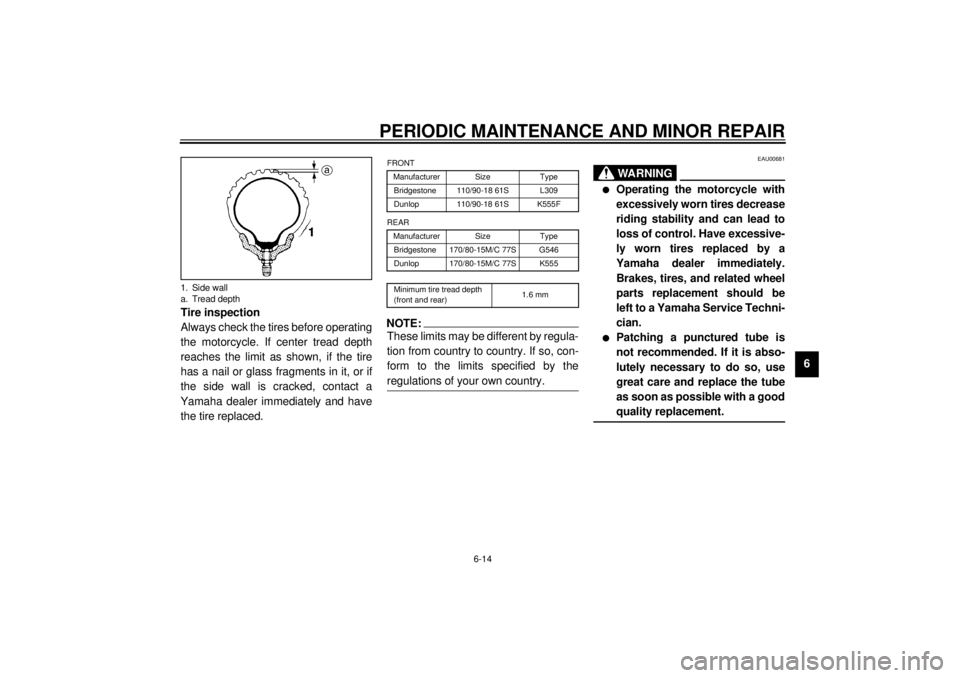
PERIODIC MAINTENANCE AND MINOR REPAIR
6-14
6 Tire inspection
Always check the tires before operating
the motorcycle. If center tread depth
reaches the limit as shown, if the tire
has a nail or glass fragments in it, or if
the side wall is cracked, contact a
Yamaha dealer immediately and have
the tire replaced.
CE-10E
CE-26ENOTE:@ These limits may be different by regula-
tion from country to country. If so, con-
form to the limits specified by the
regulations of your own country. @
EAU00681
WARNING
@ l
Operating the motorcycle with
excessively worn tires decrease
riding stability and can lead to
loss of control. Have excessive-
ly worn tires replaced by a
Yamaha dealer immediately.
Brakes, tires, and related wheel
parts replacement should be
left to a Yamaha Service Techni-
cian.
l
Patching a punctured tube is
not recommended. If it is abso-
lutely necessary to do so, use
great care and replace the tube
as soon as possible with a good
quality replacement.
@
1. Side wall
a. Tread depth
FRONT
Manufacturer Size Type
Bridgestone 110/90-18 61S L309
Dunlop 110/90-18 61S K555F
REAR
Manufacturer Size Type
Bridgestone 170/80-15M/C 77S G546
Dunlop 170/80-15M/C 77S K555
Minimum tire tread depth
(front and rear)1.6 mm
E_5el_Periodic.fm Page 14 Monday, May 1, 2000 9:44 AM
Page 80 of 96

MOTORCYCLE CARE AND STORAGE
7-3
71. Clean your motorcycle with cold
water and soap after the engine
has cooled down.
ECA00012
CAUTION:@ Do not use warm water since it in-
creases the corrosive action of the
salt. @2. Be sure to apply a corrosion pro-
tection spray on all (even chrome-
and nickel-plated) metal surfaces
to prevent corrosion.After cleaning
1. Dry the motorcycle with a chamois
or an absorbing cloth.
2. Use a chrome polish to shine
chrome, aluminum and stainless-
steel parts, including the exhaust
system. (Even the thermally in-
duced discoloring of stainless-
steel exhaust systems can be re-
moved through polishing.)
3. To prevent corrosion, it is recom-
mended to apply a corrosion pro-
tection spray on all (even chrome-
and nickel-plated) metal surfaces.
4. Use spray oil as a universal clean-
er to remove any remaining dirt.
5. Touch up minor paint damage
caused by stones, etc.
6. Wax all painted surfaces.
7. Let the motorcycle dry completely
before storing it or covering it.
EWA00001
WARNING
@ Make sure that there is no oil or wax
on the brakes and tires. If neces-
sary, clean the brake discs and lin-
ings with a regular brake disc
cleaner or acetone, and wash the
tires with warm water and mild soap.
Then, carefully test the motorcycle
for its braking performance and cor-
nering behavior. @
ECA00013
CAUTION:@ l
Apply spray oil and wax spar-
ingly and wipe off any excess.
l
Never apply oil or wax on rub-
ber and plastic parts, but treat
them with a suitable care prod-
uct.
l
Avoid using abrasive polishing
compounds as they wear away
the paint.
@NOTE:@ Consult a Yamaha dealer for advice on
what products to use. @
E_5el_Cleaning.fm Page 3 Monday, May 1, 2000 9:46 AM
Page 86 of 96

SPECIFICATIONS
8-3
8
Air pressure (cold tire)
Up to 90 kg load*
Front 200 kPa (2.00 kg/cm
2, 2.00 bar)
Rear 225 kPa (2.25 kg/cm2, 2.25 bar)
90 kg load ~ maximum
load*
Front 225 kPa (2.25 kg/cm2, 2.25 bar)
Rear 250 kPa (2.50 kg/cm2, 2.50 bar)
* Load is total weight of cargo, rider, passenger and accessories.
Wheels
Front
Type Spoke
Size 18 ´ 2.15
Rear
Type Spoke
Size 15M/C ´ MT4.50
Brakes
Front
Type Dual disc brake
Operation Right hand operation
Fluid DOT 4Rear
Type Single disc brake
Operation Right foot operation
Fluid DOT 4
Suspension
Fr o n t
Ty p e Te l e s c o p i c f o r k
Rear
Type Swingarm (link suspention)
Shock absorber
Front Coil spring / oil damper
Rear Coil spring / gas-oil damper,
spring preload adjustable
Wheel travel
Front 140 mm
Rear 113 mm
Electrical
Ignition system T.C.I. (digital)
Charging system
Type A.C. magneto
Standard output 14 V, 350 W@ 5,000 r/min
Battery
Type GT14B-4
Voltage, capacity 12 V, 12 AH
E_5el_Spec.fm Page 3 Monday, May 1, 2000 9:47 AM
Page 93 of 96
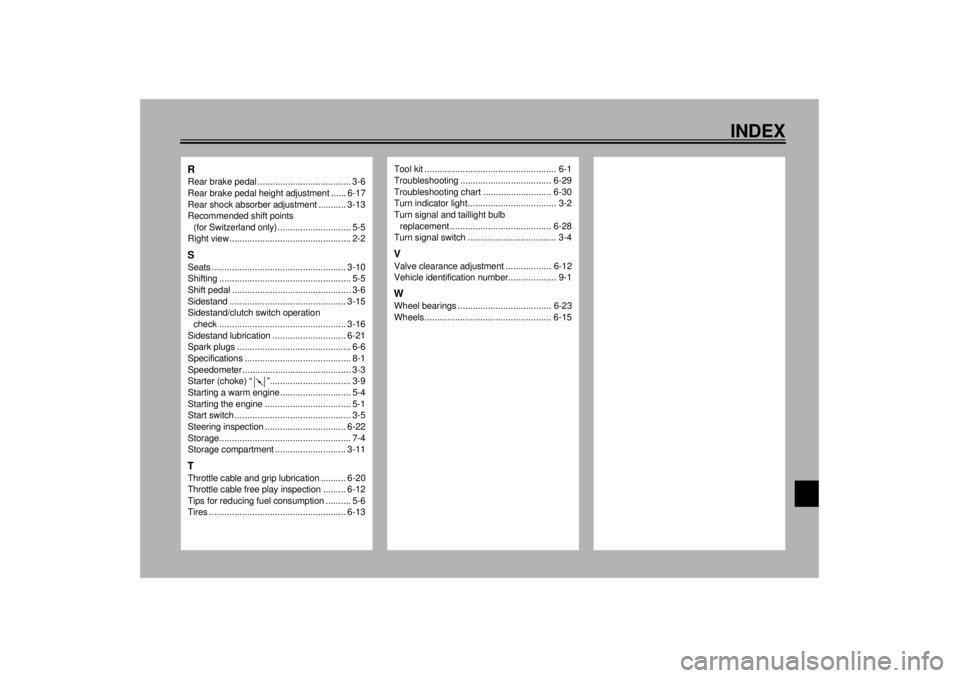
INDEX
RRear brake pedal ..................................... 3-6
Rear brake pedal height adjustment ...... 6-17
Rear shock absorber adjustment ........... 3-13
Recommended shift points
(for Switzerland only)............................. 5-5
Right view................................................ 2-2SSeats ..................................................... 3-10
Shifting .................................................... 5-5
Shift pedal ............................................... 3-6
Sidestand .............................................. 3-15
Sidestand/clutch switch operation
check .................................................. 3-16
Sidestand lubrication ............................. 6-21
Spark plugs ............................................. 6-6
Specifications .......................................... 8-1
Speedometer ........................................... 3-3
Starter (choke) “ ”................................ 3-9
Starting a warm engine ............................ 5-4
Starting the engine .................................. 5-1
Start switch .............................................. 3-5
Steering inspection ................................ 6-22
Storage.................................................... 7-4
Storage compartment ............................ 3-11TThrottle cable and grip lubrication .......... 6-20
Throttle cable free play inspection ......... 6-12
Tips for reducing fuel consumption .......... 5-6
Tires ...................................................... 6-13
Tool kit .................................................... 6-1
Troubleshooting .................................... 6-29
Troubleshooting chart ........................... 6-30
Turn indicator light................................... 3-2
Turn signal and taillight bulb
replacement ........................................ 6-28
Turn signal switch ................................... 3-4VValve clearance adjustment .................. 6-12
Vehicle identification number................... 9-1WWheel bearings ..................................... 6-23
Wheels .................................................. 6-15
E_5elIX.fm Page 2 Monday, May 1, 2000 9:48 AM